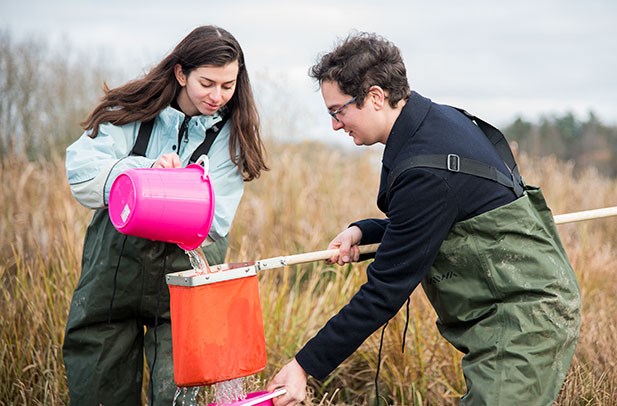Three new projects on how climate change affects pollutants in soil and water

Steffen Keiter, Jana Geuer and Manon Fallet.
Climate change and pollutants are a common theme for three research projects at Örebro University. These projects aim to understand how existing pollutants in soil and water – and ultimately humans, animals, and nature – are affected by climate changes, the warming climate and more acidic lakes and seas.
“Society must be prepared for the consequences of climate change – not least when it comes to environmental pollutants,” says Steffen Keiter, a researcher in biology.
Cobalt and lithium are two precious metals needed for the transition to a fossil-free society and to reduce our climate impact, but at the same time, these can lead to further pollution.
“I will investigate whether these metals are affected by climate changes – and if so, how,” says Jana Geuer, who has received research funding from the Marie Curie programme.
Cobalt and lithium are components used in batteries for electric vehicles. However, the current recycling of these metals is inadequate, which means a risk that large amounts of these could end up in the environment.
“Cloudbursts and floods could contribute to pollutants being spread out more extensively in the future. We will investigate whether these metals become more toxic, increase their mobility, and spread more easily when temperatures rise, increasing acidity in lakes and seas,” says Jana Geuer.
The impact of rising water temperatures
As land temperatures rise, pH values in lakes and seas drop because these waters absorb up to 25 per cent of the carbon dioxide in the atmosphere. These changes affect ecosystems and marine species – and is the subject of the second project.
“We will investigate what happens when these waters become warmer and more acidic, simultaneously exposing the zebrafish to harmful PFOS chemicals. These chemicals have been used extensively in many products, not least in fire extinguishers and paper products – and now they are present in our environment,” says Manon Fallet, who leads the research project funded by Formas.
Researchers will investigate how fish’s metabolism, development, and behaviour change are affected. Manon Fallet is examining the zebrafish at the cellular level – and their epigenetics.
Connection between genetics and the environment
Our DNA, the genes in our genome, is the blueprint determining how we look and our bodily functions. Although all cells in our bodies contain the same genes, these are used in different ways depending on the cell type. Different genes are switched on or off in muscle cells and skin cells. Epigenetics is a link between heredity and environment – and is affected by our environment.
“Evolution takes a long time, so it cannot help us adjust to climate changes. However, epigenetics can change quickly and adapt us to new conditions. We want to understand how this works to understand how pollution of the environment affects the development of animals and humans, both in the long and short term,” says Manon Fallet, a researcher in biology.
Zebrafish are widely used in research because 70 per cent of our diseases have an equivalent in these small fish. In this way, the knowledge can be used in human health.
“But it’s just as important to understand how the new conditions affect life in the sea,” says Manon Fallet.
A carbon sink and source of environmental pollutants

The third project is part of the research school Watch, which has received research funding from Formas and deals with sediment on lake and sea bottoms.
“Sediment plays a dual role, as a carbon sink and a source for environmental pollutants – both of which are affected by climate changes,” says Steffen Keiter.
Since old and new discharges are stored in the sediment, they are an essential part of the ecosystem and a habitat for bottom-dwelling plants and animals. However, pollutants found at the bottom of the sea can also spread in the water.
“We will investigate how the temperature and pH value of the water affect the pollutants in the sediment. For example, whether or not they become more soluble and mobile,” says Steffen Keiter.
“This knowledge will be used in supporting the development of environmental risk assessments of contaminated sediment, taking into account climate change conditions,” says Steffen Keiter.
All three projects aim to understand the impact of climate change on chemicals and pollutants and, ultimately, on health and the environment to manage the consequences that this may bring about.
Text: Linda Harradine
Photo: Linda Harradine/Jerry Gray
Translation: Jerry Gray
